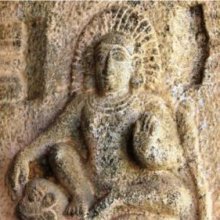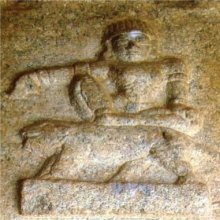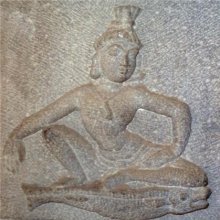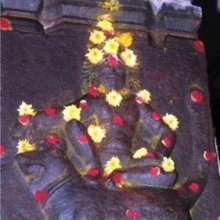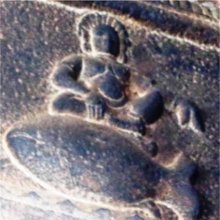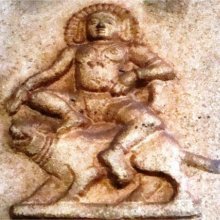Hastamudra, Hastamudrā, Hasta-mudra: 2 definitions
Introduction:
Hastamudra means something in Hinduism, Sanskrit. If you want to know the exact meaning, history, etymology or English translation of this term then check out the descriptions on this page. Add your comment or reference to a book if you want to contribute to this summary article.
Images (photo gallery)
(+26 more images available)
In Hinduism
Shaktism (Shakta philosophy)
Source: Google Books: ManthanabhairavatantramHastamudrā (हस्तमुद्रा) or simply Hasta is the name of the Gesture (mudrā) associated with Kāmarūpa, one of the sacred seats (pīṭha), according to the Ṣaṭsāhasrasaṃhitā, an expansion of the Kubjikāmatatantra: the earliest popular and most authoritative Tantra of the Kubjikā cult.—On the basis of hardly more than a hint in the Ṣaṭsāhasrasaṃhitā, it outlines a scheme of sixteen parts for each seat, conscious, no doubt, that this is an ideal number. The commentary normally limits itself to do no more than explain what is presented in the text. This is one of the few instances it adds substantially to its contents [i.e., the Gestures—Hasta]. Presumably this is because when it was written the presentation of the features of the seats on this model was the accepted norm.

Shakta (शाक्त, śākta) or Shaktism (śāktism) represents a tradition of Hinduism where the Goddess (Devi) is revered and worshipped. Shakta literature includes a range of scriptures, including various Agamas and Tantras, although its roots may be traced back to the Vedas.
Natyashastra (theatrics and dramaturgy)
Source: Shodhganga: Elements of Art and Architecture in the Trtiyakhanda of the Visnudharmottarapurana (natya)Hastamudrā (हस्तमुद्रा) refers to “hand postures” (in Indian Dramas), according to the Viṣṇudharmottarapurāṇa, an ancient Sanskrit text which (being encyclopedic in nature) deals with a variety of cultural topics such as arts, architecture, music, grammar and astronomy.—The hand postures are termed as hastamudrās in Sanskrit. The hastamudrās are very essential to denote some particular action or state in dancing and these mudrās are formed with the help of hands and fingers. In the Viṣṇudharmottarapurāṇa the necessity of hand gestures are highly recommended as according to this book, Dance depends on the actions of the hands. In the Viṣṇudharmottarapurāṇa mainly three kinds of hastamudrās are discussed and those are termed as hasta.

Natyashastra (नाट्यशास्त्र, nāṭyaśāstra) refers to both the ancient Indian tradition (shastra) of performing arts, (natya—theatrics, drama, dance, music), as well as the name of a Sanskrit work dealing with these subjects. It also teaches the rules for composing Dramatic plays (nataka), construction and performance of Theater, and Poetic works (kavya).
See also (Relevant definitions)
Partial matches: Hasta, Mudra.
Full-text (+197): Hasta, Hand gesture, Ardhacandra, Anjali, Kartarimukhahasta, Kartarimukha, Angikabhinaya, Hamsasya, Ahishirsha, Gaja, Dhyana, Dola, Dharmacakra, Shikharahasta, Pushpaputahasta, Shukatundahasta, Sucyasyahasta, Uragashirshahasta, Sandamshahasta, Karkatahasta.
Relevant text
Search found 5 books and stories containing Hastamudra, Hastamudrā, Hasta-mudra, Hasta-mudrā; (plurals include: Hastamudras, Hastamudrās, mudras, mudrās). You can also click to the full overview containing English textual excerpts. Below are direct links for the most relevant articles:
Vishnudharmottara Purana (Art and Architecture) (by Bhagyashree Sarma)
2.1. Origin of Dance (Nṛtta) and Hand-postures (Hasta-mudrā) < [Chapter 3 - Drama and Dance]
2.2. Hand Postures (a): Asaṃyukta-hasta < [Chapter 3 - Drama and Dance]
2.2. (d): Hand Gestures for Daśāvatāra < [Chapter 3 - Drama and Dance]
Dasarupaka (critical study) (by Anuru Ranjan Mishra)
Part 1 - Vararuci—The author and the date of the play (Ubhayābhisārikā) < [Chapter 2 - Bhāṇa (critical study)]
Matangalila and Hastyayurveda (study) (by Chandrima Das)
Mythological motifs related to Elephants < [Chapter 4]
Elephants in Śaivism < [Chapter 4]
Gati in Theory and Practice (by Dr. Sujatha Mohan)
Gati in classical forms especially Bharatanṛtya < [Chapter 4 - Practice of Gati]
The Skanda Purana (by G. V. Tagare)
Chapter 54 - The Greatness of Piśācamocana Tīrtha < [Section 2 - Uttarārdha]
